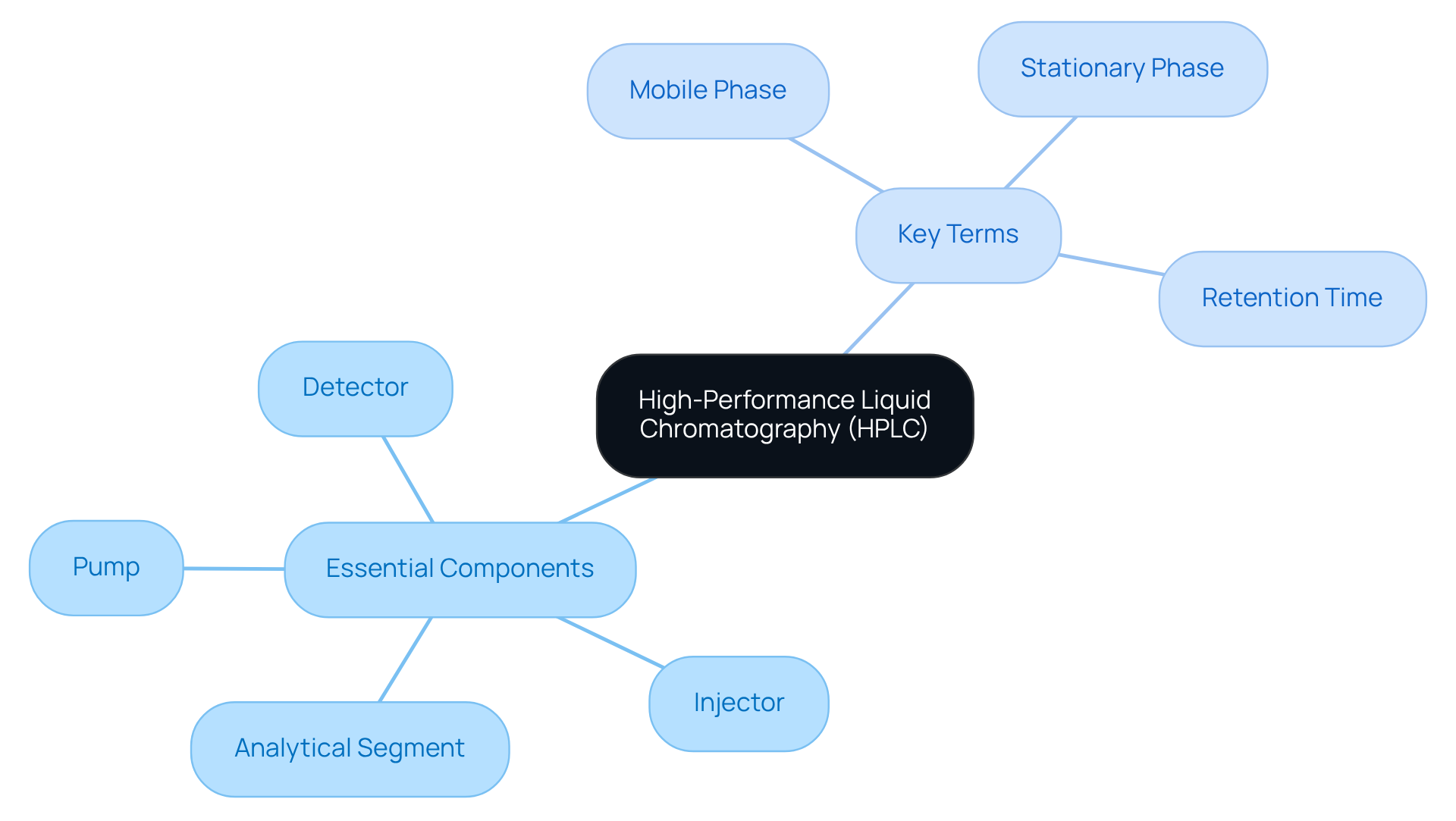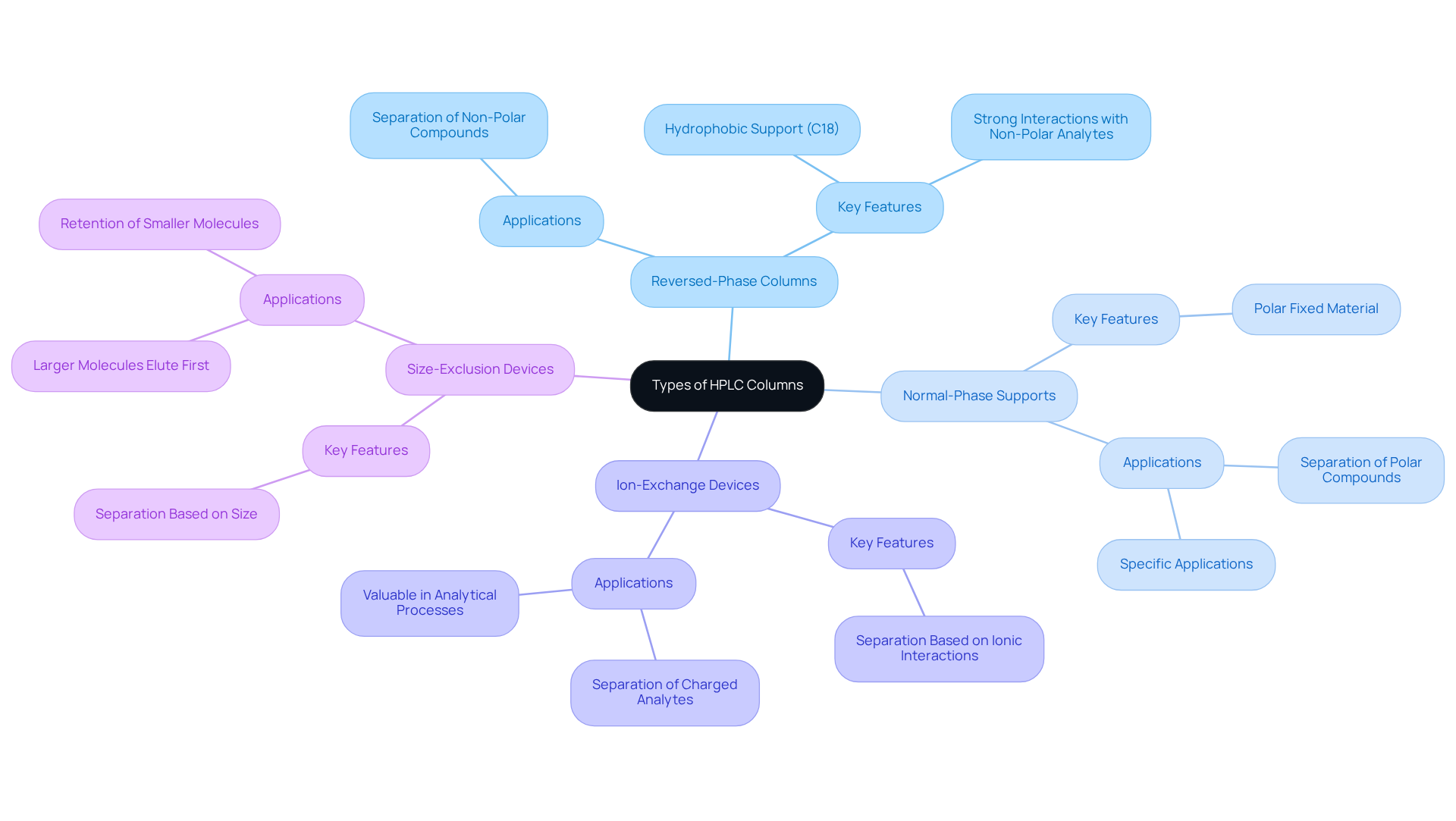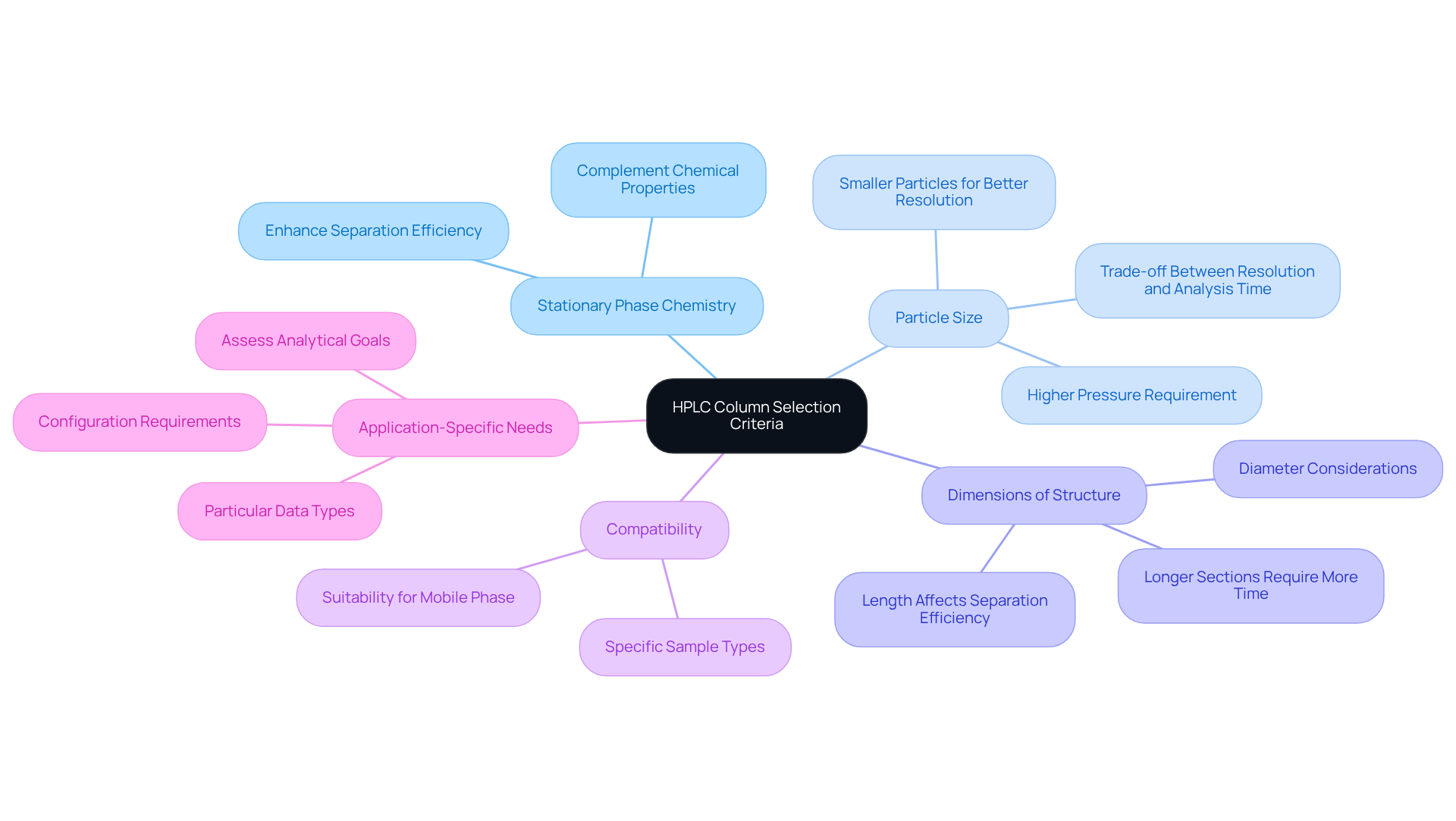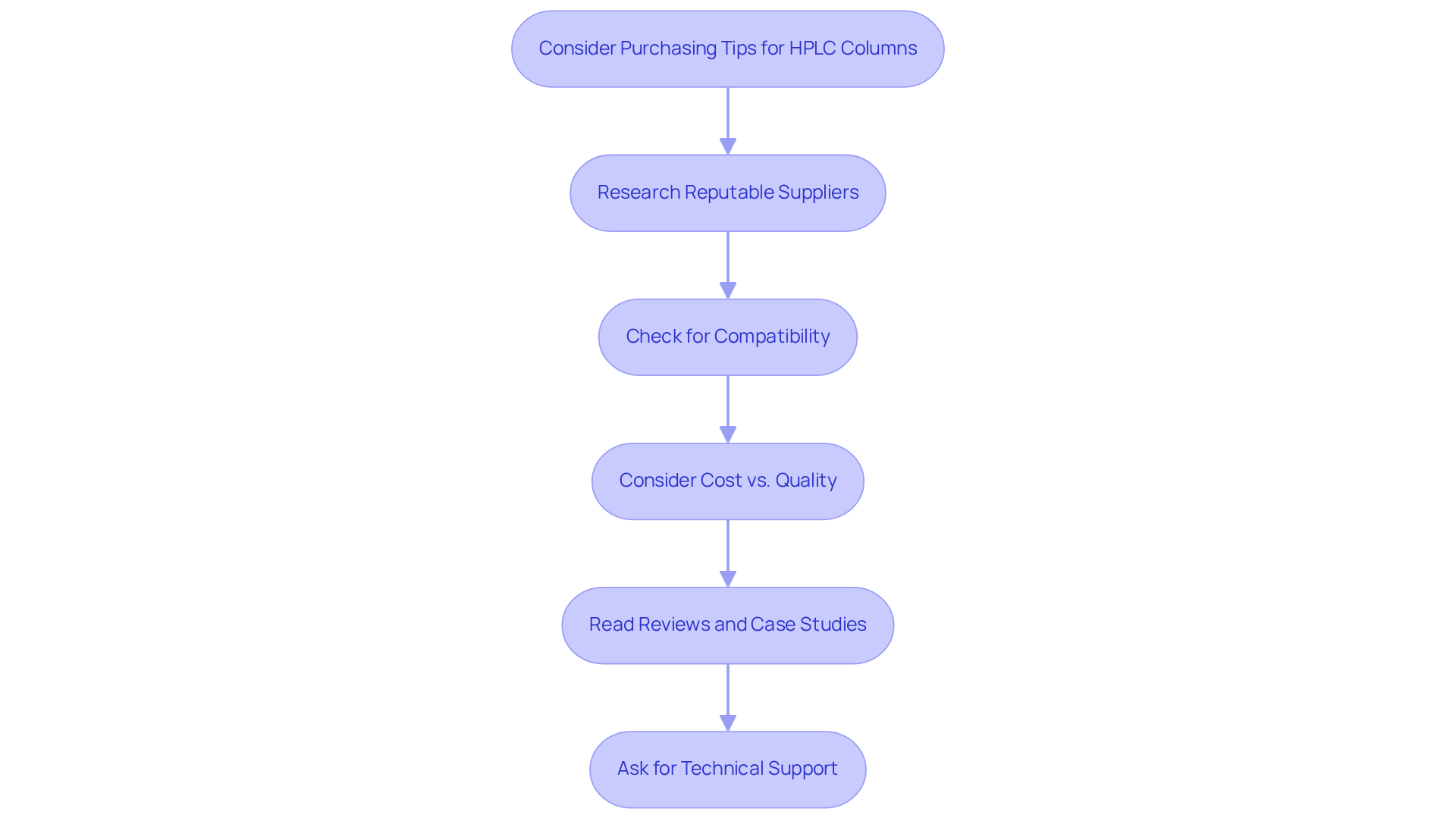Overview
The article presents a systematic approach to selecting the appropriate HPLC chromatography column, emphasizing four essential steps:
- Understanding HPLC fundamentals
- Exploring various column types
- Determining selection criteria
- Considering purchasing tips
Each step is bolstered by detailed explanations of critical factors, including stationary phase chemistry, particle size, and supplier reliability. These elements collaboratively guide users in making informed and effective choices tailored to their analytical needs.
Introduction
Selecting the appropriate HPLC chromatography column is critical to the success of analytical processes. Yet, many researchers may feel overwhelmed by the vast array of options available. A solid grasp of high-performance liquid chromatography and its diverse column types enables researchers to navigate this intricate landscape confidently. Key criteria differentiate one column from another, and understanding these factors is essential to ensure that the chosen column aligns with specific analytical needs. This guide explores the vital steps and considerations for selecting the ideal HPLC column, empowering readers to make informed decisions that will enhance their laboratory outcomes.
Understand High-Performance Liquid Chromatography (HPLC)
High-Performance Liquid Chromatography is a sophisticated analytical method that plays a crucial role in separating, identifying, and quantifying components within a mixture. By allowing a liquid sample to flow through a packed structure, various components interact with the immobile medium to differing extents. This interaction results in the separation of compounds based on their unique chemical properties.
Understanding the fundamentals of high-performance liquid chromatography column, including essential elements such as:
- Pump
- Injector
- Analytical segment
- Detector
is vital for anyone looking to select the appropriate chromatography segment for their specific applications. Moreover, familiarity with key terms like:
- Mobile phase
- Stationary phase
- Retention time
will significantly enhance your ability to make informed decisions in subsequent steps.

Explore Different Types of HPLC Columns
HPLC chromatography columns are available in various types, each specifically designed to meet distinct separation needs. Among the most common types are:
- Reversed-Phase Columns: These columns are the most widely utilized in laboratories, particularly effective for separating non-polar compounds. They feature a hydrophobic support, typically C18, which establishes strong interactions with non-polar analytes, ensuring efficient separation.
- Normal-Phase Supports: While less common, these supports are essential for the separation of polar compounds, utilizing a polar fixed material. They serve specific applications where reversed-phase columns may not be suitable.
- Ion-Exchange Devices: Tailored for charged analytes, these systems excel in separating compounds based on their ionic interactions with the stationary phase, making them invaluable in various analytical processes.
- Size-Exclusion Devices: These structures are designed to separate molecules based on size, allowing larger molecules to elute first while retaining smaller ones for a longer duration.
By comprehensively understanding these types of HPLC chromatography columns, you can evaluate more effectively which option will best fulfill your analytical needs.

Determine Selection Criteria for HPLC Columns
When selecting an HPLC chromatography column, it is essential to consider several critical criteria that can significantly impact your analytical outcomes.
-
Stationary Phase Chemistry is paramount; the chemical nature of the stationary phase directly influences its interaction with analytes. It is advisable to choose a phase that complements the chemical properties of your target compounds to enhance separation efficiency.
-
Particle Size also plays a crucial role. Smaller particles typically provide better resolution, but they may necessitate higher pressure. Therefore, it is important to weigh the trade-off between resolution and analysis time carefully.
-
Next, consider the Dimensions of the Structure. The length and diameter can greatly affect both separation efficiency and analysis time. Generally, longer sections yield improved separation but require more time to execute, which is a vital consideration in method development.
-
Compatibility is another key factor. Ensure that the column is suitable for your mobile phase and the specific types of samples you will analyze to avoid potential issues during the separation process.
-
Lastly, address any Application-Specific Needs. Different applications may require particular data types or configurations. Assessing your analytical goals will help you determine the best fit for your needs.
By thoroughly evaluating these criteria, you can make a well-informed choice when selecting an HPLC chromatography column, ultimately enhancing the quality and reliability of your analytical results.

Consider Purchasing Tips for HPLC Columns
When purchasing an HPLC chromatography column, it is essential to consider several key factors to ensure optimal selection and performance.
-
Research Reputable Suppliers: Begin by choosing suppliers recognized for their quality and reliability. JM Science Inc. stands out as a trusted partner in the scientific community, offering an extensive range of high-quality chromatography tubes, including Shodex, CapcellPak, and Reprosil, along with essential accessories at competitive prices.
-
Check for Compatibility: Next, verify that your chosen columns are compatible with your existing HPLC system and the solvents you intend to use. JM Science provides comprehensive specifications to assist you in making informed decisions.
-
Consider Cost vs. Quality: While it may be tempting to opt for the least expensive option, investing in high-quality products from JM Science can yield superior results and extend the lifespan of your equipment, ultimately leading to cost savings over time.
-
Read Reviews and Case Studies: Additionally, seek feedback from other users to assess the performance of the product in practical applications. JM Science's case studies offer valuable insights into the effectiveness of their offerings, reinforcing their reputation for quality.
-
Ask for Technical Support: Finally, do not hesitate to reach out to suppliers for guidance in selecting the most suitable option for your specific requirements. JM Science is known for providing excellent technical support, ensuring you make the best choice.
By adhering to these guidelines, you significantly enhance your chances of selecting the right HPLC column that aligns with your laboratory's analytical needs.

Conclusion
Selecting the right HPLC chromatography column is a pivotal decision that can significantly affect the quality and reliability of analytical results. Understanding the principles of high-performance liquid chromatography and the various types of columns available empowers researchers to navigate their options confidently and make informed choices tailored to their specific analytical needs.
This article outlines essential steps in the selection process, including:
- A thorough understanding of the types of HPLC columns—such as reversed-phase, normal-phase, ion-exchange, and size-exclusion columns.
- The critical criteria to consider, including stationary phase chemistry, particle size, and compatibility with the mobile phase.
- Practical purchasing tips that emphasize the importance of sourcing from reputable suppliers, ensuring compatibility, and investing in quality products for long-term benefits.
Ultimately, making a well-informed decision when selecting an HPLC column not only enhances analytical outcomes but also contributes to the overall efficiency of laboratory processes. By applying the insights and strategies discussed, researchers can optimize their chromatography practices, leading to more reliable results and advancing their scientific endeavors.




